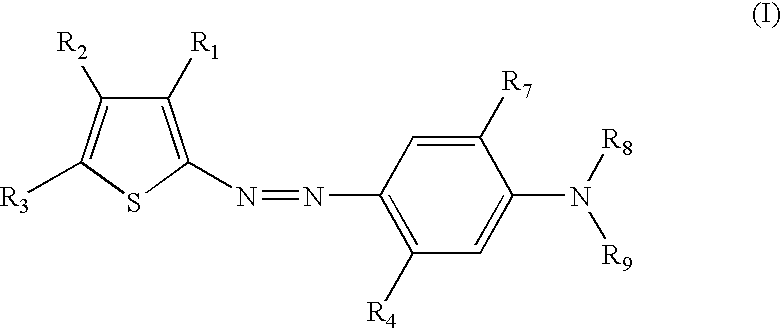[0007] Therefore, an object of the invention is to provide a
single component bluing agent for polyester fibers and articles that exhibits very low extraction therefrom, excellent anti-yellowing results therein (within the plastic alone or in combination with a yellowing additive, such as an
UV absorber compound), and high brightness (
c value) levels and whiteness (L value) levels (in accordance with CIELab standards). Another object of the invention is to provide a liquid bluing agent exhibiting .
lambda..sub.max measurements between 565 and 590 nm wavelengths and half-height bandwidths within a
narrow range of at most about 115 nm. Additionally, it is an object of this invention to provide a liquid dispersion or solution bluing agent / UV absorber formulation for introduction within polyester resins for
UV protection and anti-yellowing properties.
[0010] Other important benefits from such an inventive single compound polyester toner include low
haze results within clear articles (including pre-form as well as finished bottles), sufficiently
high absorption levels for highly effective yellow neutralization at relatively low toner loading levels, and proper
hue angle readings.
Haze is a very important property of polyester articles, particularly for food stuff and liquid containers, as the
consumer expects and generally requires the ability to view the contained matter therein when stored. For that matter, such contained liquid and / or foodstuffs also generally require the presence of UV absorbers within the polyester as well in order to prevent degradation thereof due to UV
exposure. Such UV absorbers, as noted above, can discolor (yellow) the resin thereby necessitating the presence of such bluing agents for evident reasons. Thus, with the presence of additives for these purposes, the potential for transparency reduction in the article increases. Such a requirement is not limited to finished containers, but also pre-form (pre-blown) articles as well. Thicker pre-form articles must exhibit minimal haze in order to ensure proper re-heating and blowing to consequently form the finished article, not to mention effective transparency within the finished article as well. The inventive single compound toner, to the contrary, does not deleteriously effect such a property, either in pre-form or finished articles. Such a compound also can be added in very low amounts, from about 0.1 to about 100 ppm of the total parts of polyester (such as
polyethylene terephthalate as one highly preferred, non-limiting example; others include PEN,
polybutylene terephthalate,
polytrimethylene terephthalate,
polylactic acid, and the like), preferably from about 1 to about 50 ppm, more preferably from about 1.5 ppm to about 40, and most preferably from about 2 to about 25 ppm. Even at such low loadings, the
high absorption levels within the needed range of wavelengths, as noted above, provide sufficient yellowness neutralization heretofore unseen for single compound toners. The
hue angle results contribute to the overall brightness of the resin as well, thereby according a highly desirable end product. The level of loadings depends highly upon the strength of the colorant needed to provide the desired anti-yellowing effect while also not contributing an excess in blue or violet discoloration to the target resin. Furthermore, the end-use itself may justify higher loadings (such as as high as 100 ppm) if the thickness of the target article is sufficiently low such that the amount of yellowing additives is high throughout and discoloration by bluing agents is unlikely at higher loading levels.
 Login to View More
Login to View More 
